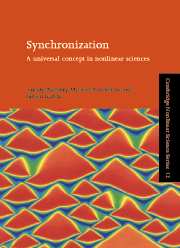Book contents
- Frontmatter
- Contents
- Preface
- Chapter 1 Introduction
- Part I Synchronization without formulae
- Chapter 2 Basic notions: the self-sustained oscillator and its phase
- Chapter 3 Synchronization of a periodic oscillator by external force
- Chapter 4 Synchronization of two and many oscillators
- Chapter 5 Synchronization of chaotic systems
- Chapter 6 Detecting synchronization in experiments
- Part II Phase locking and frequency entrainment
- Part III Synchronization of chaotic systems
- Appendices
- References
- Index
Chapter 6 - Detecting synchronization in experiments
Published online by Cambridge University Press: 06 July 2010
- Frontmatter
- Contents
- Preface
- Chapter 1 Introduction
- Part I Synchronization without formulae
- Chapter 2 Basic notions: the self-sustained oscillator and its phase
- Chapter 3 Synchronization of a periodic oscillator by external force
- Chapter 4 Synchronization of two and many oscillators
- Chapter 5 Synchronization of chaotic systems
- Chapter 6 Detecting synchronization in experiments
- Part II Phase locking and frequency entrainment
- Part III Synchronization of chaotic systems
- Appendices
- References
- Index
Summary
In this chapter we dwell on techniques of experimental studies of synchronization and give some practical hints for experimentalists. Previously, presenting different features of this phenomenon, we illustrated the theory with the results of a number of experiments and observations. In those examples the presence (or absence) of synchronization was quite obvious, but this is not always the case. Actually, detection of synchronization of irregular oscillators is not an easy task. A simple visual inspection of signals, as was done by Huygens in his experiments with clocks, is not always sufficient, and special techniques of data analysis are required. Indeed, the mere estimation of phase and frequency from a complex time series, especially from a nonstationary one, is a complicated problem, and we begin with its discussion. Next, we proceed in two directions: first, we summarize how to determine the synchronization properties of oscillator(s) experimentally; second, we use the idea of synchronization to analyze the interdependence between two (or more) scalar signals. Some technical details of data processing are given in Appendix A2.
Estimating phases and frequencies from data
Synchronization arises as the appearance of a relationship between phases and frequencies of interacting oscillators. For periodic oscillators these relations (phase and frequency locking) are rather simple (see Eqs. (3.3) and (3.2)); for noisy and chaotic systems the definition of synchronization is not so trivial. Anyway, in order to analyze synchronization in an experiment, we have to estimate phases and frequencies from the data we measure. To be not too abstract, we consider a human electrocardiogram (ECG) and a respiratory signal (air flow measured at the nose of the subject) as examples (Fig. 6.1).
- Type
- Chapter
- Information
- SynchronizationA Universal Concept in Nonlinear Sciences, pp. 153 - 172Publisher: Cambridge University PressPrint publication year: 2001
- 1
- Cited by

